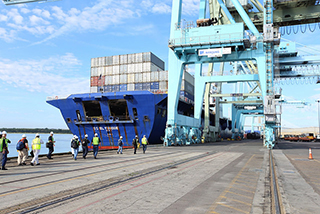The ro/ro containership El Faro and sister ship El Morro could be very tender and slower to recover from rolls when heavily loaded, a characteristic that led its officers to add more margin of safety when calculating the effects of loading, a former captain testified Tuesday to the Coast Guard marine board of inquiry investigating the Oct. 1, 2015 sinking in Hurricane Joaquin that killed all 33 crew.
Capt. Jack Hearn, who worked on TOTE Maritime ro/ro ships for years in the Alaska trade, recalled the differences when he moved to TOTE’s Sea Star Line division and sailed on the Ponce-class ships for the Jacksonville, Fla., to San Juan, Puerto Rico, service.
In a straight ro/ro configuration, the TOTE vessels “were excellent ships…they handled well,” Hearn said. The combined ro/ro with container cargo is “more of a different animal, especially in rough weather,” he told the board.
"The ship was very tender,” a tendency he could feel with rudder commands, recalled Hearn who served on the line in 2007, 2009-2011 and 2012, when he charted a course to avoid Hurricane Sandy in October of that year.
When the ships rolled, they came back with “a very slow return,” Hearn said. “You could feel the ship as it leaned over.”
Board members questioned Hearn at length about stability, and he related how the ship’s metacentric height – a measure of initial static stability, expressed as GM – was modified in response to the ship movements observed by him and his officers. They added an additional 0.5' in height to GM at departures as an extra margin of safety, Hearn said.
“The Rocan (roll on/roll off/container) ship, especially if it’s heavily loaded, is slower to react,” Hearn said. Under questioning, he described how that could be a problem in bad weather.
“Once you get to about 15 degrees (roll) things can start moving quicker,” Hearn said. “Cargo can stay in its place even at 30 degrees,” but at that extreme there are lots of stresses on cargo lashings, he added.
Even with an extreme list, “you would still have positive stability…that factor is quite large to destabilize a ship,” Hearn said, noting he had no reason to doubt the basic stability calculations for the Ponce-class vessels.
In testimony Monday, Jacksonville pilots who took the El Faro out on its final departure testified about what they saw and heard, including captain Michael Davidson’s plan to take the ship west and south of Hurricane Joaquin’s projected path. But the ship suffered a major casualty of its main power plant, leaving it a target for the storm.
James Franklin, chief of the hurricane specialist unit at the National Hurricane Center in Miami, began testifying later in the afternoon, explaining how the predictive models used by forecasters can vary widely in their use of data and basic assumptions. The board is looking at whether Davidson had adequate information from the NHC about the storm’s strength, speed and direction.
Hearn offered some of his experience with Sandy and other storms, such as using radar to deduce building seas state and wind at a distance. At a first round of Coast Guard hearings in February, there was discussion of whether the El Faro would have been safer on a different course west of the Bahamas.
“You have a great barrier there in the Bahama Bank,” Hearn said. But proximity to islands can be a danger too when captains need sea room to out-maneuver a storm – and hedge against weather forecasts, he said.
During Sandy, Hearn said, he headed farther out into the Atlantic and headed south to get sea room.
“If you get into the grip of the storm, where you start losing speed…you can get trapped in the conditions and the storm gets closer and closer,” he said. “With wind speeds force 7 (30 to 34 knots) and above, you’re going to have big seas very quickly.”




